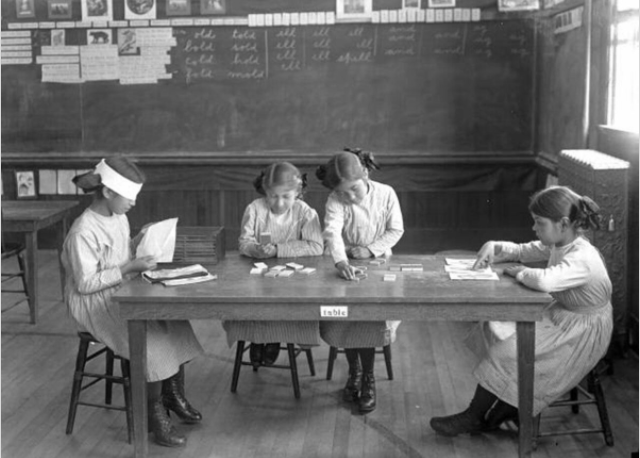[A Mathematical Conversation]
By Anonymous
Annotations by Karen Kilcup

Courtesy J. A. Juleen / Everett Public Library’s Northwest History Room.
Teacher. “Now Mary, my dear, suppose I were to shoot at a tree with five birds on it, and kill three, how many would be left?”
Mary: “Three, ma’am.”
Teacher: “No, two would be left.”
Mary: “No there wouldn’t though. The three shot would be left and the other two would be flied away.” [1]
Anonymous. [A Mathematical conversation.] The Youth’s Companion: A Juvenile Monthly Magazine Published for the Benefit of the Puget Sound Indian Missions 2, no. 1 (July 1881): 39.
[1] Presumably the observer uses “flied” to indicate that Mary is very young. We should assume that the teacher is white and that Mary is a Tulalit student.
Contexts
Begun in 1881, The Youth’s Companion—a name that many nineteenth-century publications shared—was a monthly student magazine that published articles written by pupils of the Catholic-run boarding school located on the Tulalip Indian Reservation. A federally recognized tribe located in the mid-Puget Sound area, the Tulalip Tribes received reservation lands—22,000 acres—in 1855, with its legal boundaries established by President Ulysses S. Grant in 1873. According to the Tulalip Tribes website, “it was created to provide a permanent home for the Snohomish, Snoqualmie, Skagit, Suiattle, Samish, and Stillaguamish Tribes and allied bands living in the region.”
Nineteenth-century Indian boarding schools aimed to assimilate Native Americans into white culture. They separated children from their families, required students to dress like white Americans, and prohibited them from speaking their language. They also emphasized so-called “industrial” training: boys learned agricultural and industrial skills, while girls learned how to cook, sew, and clean a household. Students were often expected to become servants or to provide manual labor help for whites.
Like many contributions to Native American student periodicals, this conversation was published anonymously. Students living on reservations during this time often received educations governed by white religious authorities who emphasized moral training. This story represents a significant change from the didactic texts that students were normally expected to compose. It showcases Native intelligence in a period when most white Americans regarded the nation’s Indigenous people as inferior or even subhuman. The conversation also emphasizes how the Tulalip child sees the world differently, and in some ways more clearly than her white teacher. Humorous sketches like these were common in Native American texts.
Resources for Further Study
- Kalliber, Kim, “Seattle Continues Healing ‘Deep Wounds’ With Boarding School Resolution,” Tulalip News, October 20, 2015.
- King, Marsha. “Tribes confront painful legacy of Indian boarding schools,” Seattle Times,February 3, 2008.
- Marr, Carolyn J. “Assimilation Through Education: Indian Boarding Schools in the Pacific Northwest,” University of Washington Libraries Digital Collection. This article includes historical contexts and features “A Typical Daily Schedule.”
- ———. “Between Two Worlds: Experiences at the Tulalip Indian Boarding School, 1905-1932,” Hibulb Cultural Center & Natural History Preserve.
Contemporary Connections
“Tulalip History Minute 04—The Tulalip Indian School presented by Mary Jane Topash,” the Tulalip History Project. Provides Tulalip-sponsored background on the tribe.
“Editorial: Getting to the truth of Tulalip boarding school,” September 26, 2021, HeraldNet (Everett, Washington). Caution: includes information about abuses at the school.